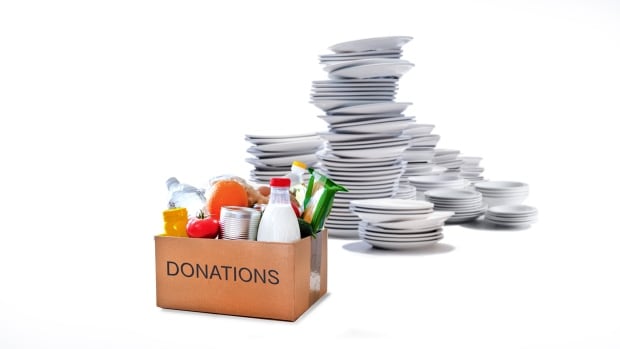This column is an opinion by Lourdes Juan, a Calgary-based entrepreneur and urban planner. For more information about CBC’s Opinion section, please see the FAQ.
Like many Canadians, I grew up being asked to donate to the local food bank. My school held regular food bank drives, where students were encouraged to bring cans of soup and boxes of macaroni to school assemblies.
I remember my mom, who worked a third job so our family of five could have access to food, would often spend what little money she had at the end of the week on hamper packs. When we went grocery shopping, I’d watch with my sisters as she placed these packages into the food bank box at our grocery store’s exit.
Food bank drives and donation boxes are everywhere, especially at this time of the year. Many of us donate without a second thought, and for good reason.
Today, 5.8 million Canadians are living in food-insecure households. This means families are making tough decisions about whether they feed themselves, feed their children, or keep the lights and heat on. This includes 1.4 million children.
And so we, as Canadians, put time and energy into food banks. We stuff buses, we leave cans out on our doorstep, we pack hampers, we teach our children about food banks, and we volunteer our time, in hopes that the 5.8 million number is lower the next year.
A temporary fix
Every year, when those donation boxes overflow or fundraising campaigns reach their goals, we celebrate. We pat ourselves on the back. We did good.
Sure donating makes people feel good, but it’s a temporary fix.
Why? Because we’re not addressing the root issue. I know this after years of working in the food space and years spent thinking about food insecurity. (Simply put, food insecurity is a lack of access to an adequate diet, meaning enough quality food.)
The arguments about food banks targeting the symptoms of food insecurity, rather than the causes, have been well made over time.
I want to be clear that food banks are essential. We will always need an emergency organization, coming to the quick rescue. They are one part of the solution, one part of the puzzle, but they also help keep people in cycles of need.
Food banks are, at best, a Band-Aid solution. These warehouses of donated food are part of a stigmatized system.
They are often physically challenging to get to, and many barriers exist to receive a hamper that may not even contain culturally-appropriate food.
Canadians receive emergency hampers from food banks after they provide answers to questions about their income and expenses, show valid ID, and travel (often great distances on public transit) to a food bank to line up and pick up their provisions.
Imagine your grocery store trip perusing aisles being replaced by a long bus ride to a warehouse, personal questions being thrown at you, and then having to lug a large box — of items you have no say over — home on the bus.
Giving at Christmas to organizations that don’t tackle the root causes of food insecurity gives the public the false impression that once the funding drive is over the problem is over. It is not.
Put simply, food banks are not the solution to hunger. Canada’s first food bank opened in Edmonton, during the 1980s recession. It was designed as a temporary solution.
Four decades later, food banks have become a mainstay in our society, even though they don’t address food insecurity.
Other pieces of the puzzle
I have spent the last decade working in what the not-for-profit sector calls the food rescue space. The work is about getting good food that would otherwise be discarded, like unused restaurant food, to service agencies in need.
This model helps community members access fresh food with more dignity. In Calgary, this helps stock a mobile grocery store where community members can get access to fresh fruits, vegetables, bread and eggs at an affordable cost.
This is food that is culturally appropriate, sold close to where they work or live and it’s a welcoming place where they can shop with neighbours, and where they don’t have to prove how poor they are to access their basic needs.
Working to find solutions like this with people who experience food insecurity brings dignity and empowerment to the process.

I have seen so much good come from learning what community members want out of food access. How there are better paths, like community food centres that offer restaurant-style dinners and cooking classes.
Gift-card programs that put the power of purchasing into the hands of families themselves.
Community fridges, where anyone can drop off a donation in their neighbourhood.
Local currency programs that encourage local consumption. And I’m part of a new pay-what-you-want model that offers people choice, so that if they need to pay their electrical bill that week, they can pay a little less for food.
Food access should not come at a cost to someone’s dignity. It needs to be affordable, convenient, year-round, culturally appropriate, and proof of income shouldn’t be a barrier to entry.
I grew up donating to local food banks and being taught that they were the way people less fortunate than us got food.
I want my son to grow up knowing that solving hunger is about so much more than handing someone a hamper of macaroni and pasta sauce.
Do you have a strong opinion that could add insight, illuminate an issue in the news, or change how people think about an issue? We want to hear from you. Here’s how to pitch to us.


